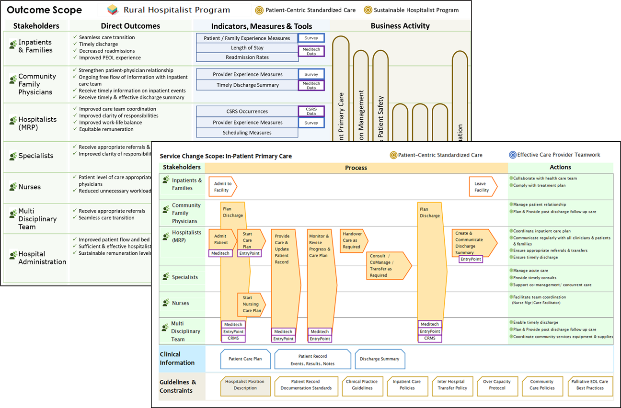Leah is leading the design of a new case management system for five different social services areas that often serve the same clients. Currently each service area operates as a silo and one of the strategic goals of this new system is to improve service quality and efficiency by moving from program centric to client centric service delivery. This will of course involve significant process change along with cultural change.

Louise Harris, President, SToS Inc.
Louise will be speaking at the IRM UK Enterprise Architecture & Business Process Management Conference Europe 21-24 October 2019, London on the subject, ‘The Scientific Principles for Creating Intuitive Diagrams for your Business Stakeholders‘ and ‘Value Modelling for More Successful Process Change.’
Leah has been involved in similar change initiatives before and all of them were painful. They took much longer than expected, were drastically over budget and created a lot of confusion, stress and in-fighting. Missing, ambiguous, and contradictory requirements resulted in systems that didn’t fully meet anyone’s needs, required inefficient workarounds to support old processes, had features that did not work correctly at all and in the end, failed to enable cultural change. Does this sound familiar to you?
Leah does not want to lead a disaster, so she set about answering the question “What makes change successful?”
Synthesizing many research articles, discussions with colleagues and her own reflections, led to two essential factors. Change is successful when
- The value delivered by the change is greater than the cost to implement and operate the change.
- There is a laser focus on achieving (1)
This may seem incredibly oversimplified to you. Her executive steering committee certainly thought so. However, now that she had their attention, this is how Leah unpacks it to them.
Value > Cost
Value is the motivating factor for change and cost is the demotivating factor. Both the organization executive and the stakeholder groups operationalizing the change need to be motivated to invest in the change. That is, they need to believe that they value they will receive will be worth more than the cost they must invest. The challenge with most large organizational change undertakings is that neither the perceived value nor the anticipated cost is realistically and clearly articulated.
If those operationalizing the change don’t perceive, that is understand and believe in, the value of the change, they will not be very motivated to work towards a successful implementation. If the organization leadership do not understand the impact of the change on the current formal and informal systems and processes, they will underestimate the scope of the change. This means the anticipated costs will also be too low. Often, by the time the impact and full scope is understood, the envisioned solution has already been partially built or implementation has started. This means the cost of rework, in dollars, time and human energy is significantly more than if the full scope had been correctly ascertained in the first place.
Laser Focus
Leah is convinced that establishing a laser focus on identifying the value and cost of the new case management system, including processes, technology and people, is the place to start. She suspects that the current articulation of the reason for the change is not relevant and compelling to all impacted stakeholder groups. Therefore, their commitment to engage and the quality of their contributions will be low. Leah proposes four critical steps and one critical success factor for making an informed decision on scope. The four critical steps that enable a laser focus on value and cost are:
- Articulate the desired value and expected outcomes of the change to the organization and the stakeholder groups that will be operationalizing the change
- Identify everyone’s current challenges and hindrances in achieving those expected outcomes.
- Identify and rate what needs to change to overcome the challenges and achieve the outcomes.
- Estimate the cost of resources and time for each of these “what needs to change” items.
Leah explains to the executive committee that the underlying critical success factor is to engage all levels of staff across all five service areas and the corporate support areas in all four of these steps. Leah’s executive team agrees this sounds great in theory, but they challenge her on how she can do this effectively in a short time frame. They want to decide on scope in 3 months. Leah is ready for this argument and has come armed with statistics on the cost overruns of previous not so successful change initiatives. She persuades them to increase the up-front investment to ensure a more accurate picture of the scope of the change and reduce the risk of large cost over-runs and sub-optimal value delivery.
Visual Design Tools
Leah also presents recent research on improving the effectiveness and efficiency of engaging stakeholders in scoping change. This research investigated the scientific principles of designing intuitive diagrams for depicting complex change. In one study performed at a healthcare organization, clinicians and hospital administrators were able to identify significant misunderstandings and gaps in the planned scope of a service change in the span of 10 to 20 minutes using two specially designed diagrams.

The first diagram helped them clarify the organization goals the change would enable and the measurable outcomes of the change for each stakeholder group, including the clients, front line service providers and operations management. It also identified the core service and the supporting capabilities that would need to change to achieve these outcomes. The second diagram helped them succinctly identify what needed to change in the delivery of the core service to achieve the organization goals and the desired stakeholder outcomes. This includes processes, information, policies and other guidelines. It also included stakeholder actions that reflected stakeholder responsibility and interaction changes that were critical to enable achievement of the stakeholder outcomes. Lack of clarity in responsibility and interaction changes and lack of motivation and/or soft skills to execute these effectively are the cause of many hidden land mines that impede successful change. Ensuring people are motivated, enabled and accountable for these changes is a hidden cost of change that is often not recognized until it is too late.
Up-front Investment
Leah has a good reputation with the executive committee and her data and research is compelling. The executive committee agrees to take an investment view and fund three business analysts and on-the-job training in developing these diagrams for scoping this change initiative. They also agree to fund salary top-ups for staff to backfill the service area managers for one day a week. This will enable the managers to participate in the training and the scoping process. Leah negotiates to return to the committee in three months with a comprehensive scope that is ready for a realistic cost estimation and development of an implementation timeline.
Leah is excited to embark on this new approach with solid executive support. Convincing the change weary and wary service area managers that it will be worth their while to participate will be her next challenge. But that is the subject for another article.
Be sure to attend the IRM UK EA/BPM Conference October 21-24, 2019 to learn more about developing intuitive diagrams and effectively engaging stakeholders in designing change.
More information and resources on designing change and engaging stakeholders is available at the Change Design Institute
Louise has been working with organizations to design and implement digital and process transformations for over 25 years as an enterprise architect and management consultant. Her passion for helping organizations advance in collaborative, stakeholder centric design led her to embark on a PhD researching effective ways of engaging stakeholders in transformation design. Louise is an accomplished speaker, educator and hands on consultant. She is a lecturer at Memorial University in Canada and founder of the Change Design Institute. Follow Louise: @Louise_A_Harris
Copyright Louise Harris, President, SToS Inc.


